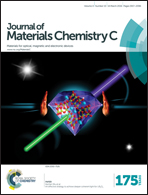Chemical epitaxy and interfacial reactivity in solution deposited PbS on ZnTe
Abstract
Despite their promise, the efficiency of quantum dot solar cells is currently low (<10%), where an improved understanding of interfaces and contact layers adjacent to the quantum dots is presently a major limitation. The present work aims at optimizing the conditions for growing PbS thin films on ZnTe in light of the solubility of ZnTe in the alkaline environment required for chemical bath deposition of PbS. The morphology and properties of these films are strongly affected by altering the solution pH, temperature and the reagent concentrations. A detailed structural and chemical analysis reveals the different orientation relationships present between the constituent layers and highlights the spontaneous formation of new, distinct intermediate layers in the unique local environment formed due to the simultaneous dissolution of the ZnTe layers in the presence of precursors for PbS thin film deposition.


 Please wait while we load your content...
Please wait while we load your content...